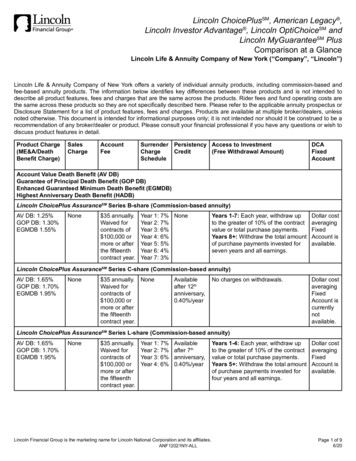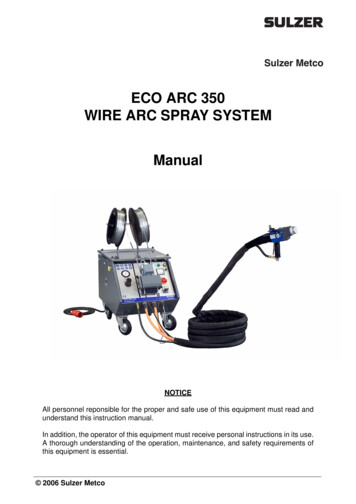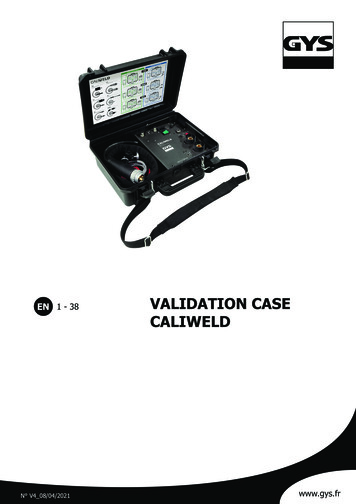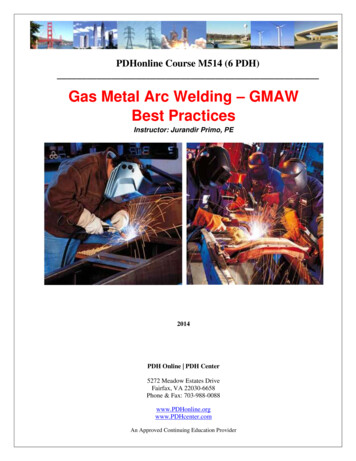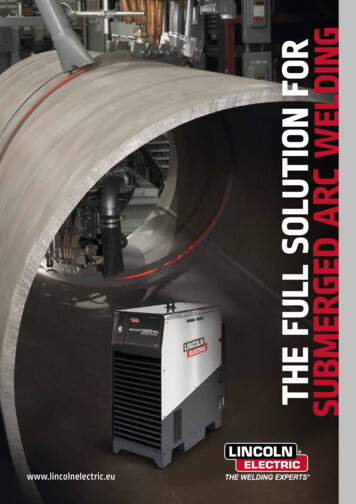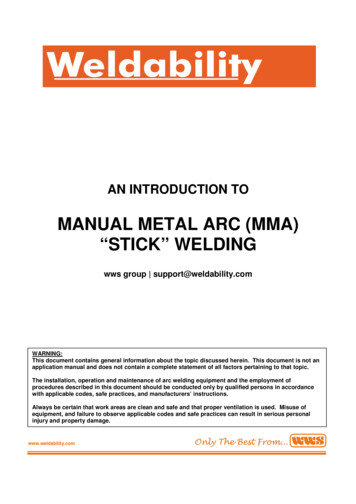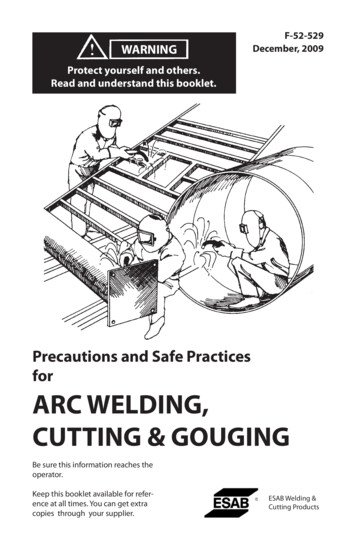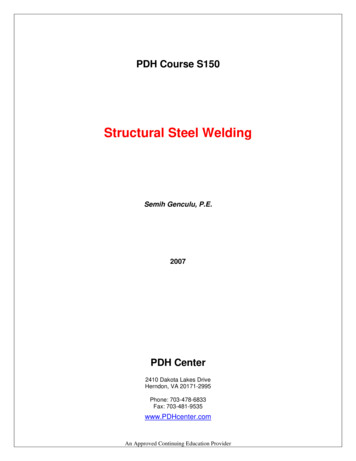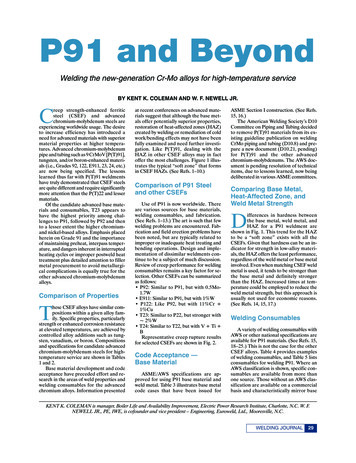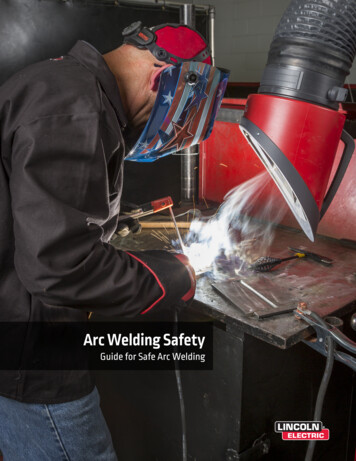
Transcription
Arc Welding SafetyGuide for Safe Arc Welding1
Safety Practices in WeldingINTRODUCTIONArc welding is a safe occupation when sufficientmeasures are taken to protect the welder frompotential hazards. When these measures areoverlooked or ignored, however, welders canencounter such dangers as electric shock,overexposure to fumes and gases, arc radiation,and fire and explosion; which may result inserious, or even fatal injuries.This bulletin is written with the arc weldingoperator in mind, containing both mandatorysafety practices and those based on shopexperience. Be sure to read ANSI Z49.1, andrefer to the other publications listed at the endof the bulletin for more detailed information onspecific topics of arc welding safety, as well as themanufacturers’ instructions and material safetydata sheets (MSDS’s).Important Note:So that you can protect yourself against thesehazards, every welder should be familiar withAmerican National Standard ANSI Z49.1,“Safety in Welding and Cutting,” and shouldfollow the safety practices in that document.Z49.1 is available for download at no charge at:http://www.lincolnelectric.com/safetyor at the AWS website http://www.aws.org.Download and read it!PERSONAL PROTECTIVE EQUIPMENTProtective ClothingWelders, like firemen, must wear clothing toprotect them from being burned. Of all injuries towelders, burns are the most common due to sparkslanding on bare skin. Welding arcs are very intenseand can cause burns to skin and eyes with just afew minutes of exposure.The actual gear varies with the job beingperformed, but generally protective clothingmust allow freedom of movement while providingadequate coverage against burns from sparks,weld spatter, and arc radiation. Many types ofclothing will protect you from ultra-violet radiationexposure, which appears as a skin burn (much likesunburn). Under the worst conditions, however,severe burns and skin cancer may result fromexcessive radiation.Because of its durability and resistance to fire, woolclothing is suggested over synthetics (which shouldnever be worn because it melts when exposedto extreme heat) or cotton, unless it is speciallytreated for fire protection. If possible, keep yourclothes clean of grease and oil, as these substancesmay ignite and burn uncontrollably in the presenceof oxygen.Avoid rolling up your sleeves and pant-cuffs,because sparks or hot metal could deposit in thefolds; also, wear your trousers outside your workboots, not tucked in, to keep particles from fallinginto your boots. While we’re on the subject, wesuggest leather high-tops with steel toes (especiallywhen doing heavy work), or metatarsal boots.Other protective wear for heavy work or especiallyhazardous situations includes: flame-resistantsuits, aprons, leggings, leather sleeves/shouldercapes, and caps worn under your helmet.Heavy, flame-resistant gloves, such as leather,should always be worn to protect your hands fromburns, cuts, and scratches. In addition, as long asthey are dry and in good condition, they will offersome insulation against electric shock.As to preventing electric shock, the key word isdry! We’ll have more on the subject later, but fornow keep in mind that moisture can increase thepotential for and severity of electric shock. Whenworking in wet conditions, or when perspiringheavily, you must be even more careful to insulateyour body from electrically “live” parts and work ongrounded metal.WARNING!ARC RAYS can burn.Wear eye, ear and body protection.Note to Arc Welding Educators and Trainers:This Arc Welding Safety brochure may befreely copied for educational purposes ifdistributed to welders and welding studentsat no additional charge.2
Safety Practices in WeldingNOISEThere are two good reasons to wear ear muffsor plugs:»» to keep flying sparks or metal out of your ears;and»» to prevent hearing loss as a result of workingaround noisy arc welding equipment, powersources, and processes (like air carbon arccutting or plasma arc cutting).As with radiation exposure to the eyes, the lengthand number of times that you are exposed to highlevels of noise determine the extent of the damageto your hearing, so be sure to avoid repeatedexposure to noise. If it is not possible to reducethe level of noise at the source (by moving eitheryourself or the equipment, utilizing sound shields,etc.), then you should wear adequate ear protection.If the noise in your work area is greater than 85 dB,or when levels become uncomfortable, causing aheadache or discomfort of the ears, you could bedamaging your hearing and should immediatelyput on ear muffs or plugs.In fact, the use of ear protection at all times is agood idea, as hearing loss is both gradual and addsup over time. Damage to your hearing may not benoticed until you have a complete hearing test, andthen it could be too late.ARC RAYSIt is essential that your eyes and skin areprotected from radiation exposure. Infraredradiation has been known to cause retinalburning and cataracts. And even a brief exposureto ultraviolet (UV) radiation can cause an eye burnknown as “welder’s flash.” While this condition isnot always apparent until several hours afterexposure, it causes extreme discomfort, and canresult in swelling, fluid excretion, and temporaryblindness. Normally, welder’s flash is temporary,but repeated or prolonged exposure can lead topermanent injury of the eyes.Other than simply not looking at an arc, theprimary preventive measure you can take is touse the proper shade lens in your helmet. Refer tothe lens shade selector chart in Supplement 1 forthe recommended shade numbers for various arcwelding processes. The general rule is to choose afilter too dark to see the arc, then move to lightershades without dropping below the minimumrating. The filters are marked as to the manufacturer and shade number, the impact-resistant varietyare marked with an “H.”Helmets and hand-held face shields (see Figure A)offer the most complete shading against arcradiation. The shade slips into a window at thefront of the shield so that it can be removed andreplaced easily. The shields are made from a hardplastic or fiberglass to protect your head, face, ears,and neck from electric shock, heat, sparks, andflames. You should also use safety glasses withside shields or goggles to protect your eyes fromflying particles.Visible light can also be harmful, but it is easyto tell if the light is dangerous: if it hurts to lookat, then it’s too bright. The same is true forinfrared radiation: it can usually be felt as heat.However, there’s no real way for you to tellif you’re being over exposed to UV radiation,so just don’t take chances: always wear eyeprotection (see Supplement 1 for recommendedlens shade numbers). UV radiation can also burnexposed skin. Always cover or shield potentiallyexposed skin to prevent burns.(a)(b)Figure A.A helmet (a) required for protecting the welder’seyes and face and (b) a hand-held face shield that isconvenient for the use of foremen, inspectors, andother spectators.3
Safety Practices in WeldingINSPECTION AND MAITNENANCE OF EQUIPMENTAND WORKBefore starting any arc welding operation, youshould make a complete inspection of yourequipment. All it takes on your part is 5-10 minutesbefore you turn on your welder; is that too muchto spend in preventing injury to yourself or yourco-workers?To begin with:»» Have you read the instruction manual and doyou understand the instructions? The instructionmanual for your welder is available upon requestto your welding distributor or the manufacturer. Manuals for Lincoln Electric welders maybe downloaded from lincolnelectric.com at nocharge.»» Have you read the warnings and instructions onthe equipment nameplates and decals as well asthe consumables labels and material safety datasheets? (For older equipment see Supplement 5to request a FREE Warning Label.)For the welder:»» Are all the connections tight, including theearth ground?»» OSHA regulations require output terminals tobe insulated. Rubber boots are available forthat purpose.»» Are the electrode holder and welding cable wellinsulated and in good condition?»» Are the settings correct for the job you’re aboutto begin?For an engine-driven welder:»» Is it running OK?»» Are all the hoses on tight?»» Is the fuel cap on tight?»» Is the engine leaking fuel or oil? Some jobsiteslook for this and may refuse entry if your engineis leaking.»» Take caution not to spill fuel when refueling.»» Have a fire extinguisher handy just in case. Fuelspresent a fire hazard and we must always followappropriate hot work procedures.»» Is the original enclosure and fan guarding inplace? Check with your welding equipmentdistributor if you are unsure. (See Supplement 6.)»» Are the cables the right size for your job? Besure any damaged cable insulation is repaired.»» Are they spread out and run neatly toprevent overheating?»» Is the gas cylinder connected properly?»» Is the cylinder secure?»» Is the work stable and easy to reach from whereyou’re standing?»» Is the Work Lead connected securely?»» Is there enough dry insulation between yourbody and the work piece?»» Is there adequate ventilation in your work area?Take some personal responsibility for your ownsafety. Notify your supervisor if equipment is inneed of repair or not working properly or anyunsafe condition. You have the most to lose ifyou get hurt. Don’t allow yourself to work in ahazardous situation without taking appropriatesafety precautions.If the hazard is serious and cannot be correctedreadily, the machine should be shut down untilthe needed repairs are made. If the problem islimited to the outside of the welder, such as aloose connection or a damaged cable that needsto be replaced, disconnect power to the welderand correct the problem per the manufacturersinstructions in the operating/service manual. Ifthe hazard requires repairs to the inside of thewelder or to the electrical input supply lines, call aservice technician or an electrician. Never attemptto make these repairs if you are untrained.Important Safety Note:Consider whether the area in which you willbe working creates or increases the level ofhazard to you thus requiring special proceduresor equipment. Factors such as electrical safety,fume ventilation/exhaust and risk of fire orexplosion may be affected. See later sectionson those topics and other documents in“Bibliography and Suggested Reading” forfurther information.For the work in general: (See also Supplements4 and 7)»» Are the work area conditions such that normalsafety precautions can be observed or mustspecial equipment (i.e., ventilation, exhaust,or respirator, welding equipment, protectiveequipment, safety equipment) or proceduresbe used?»» Many jobsites require permits for any weldingor cutting. Be sure you have any permits youwill need. Make sure that applicable hot workprocedures are followed.»» If you will be working in a confined space,many special OSHA regulations and jobsiterequirements may apply in addition to thearc welding precautions in this brochure.Understand which of these apply to yourjobsite and comply with them.4
Safety Practices in WeldingCARE AND CLEANING OF THE WORK AREAKeeping the area around your work neat is asimportant as maintaining your equipment. Perhapseven more-so, as the risk of injury is amplified bythe larger group of people involved. You may havealready inspected your equipment and found it tobe OK, but all your caution won’t matter when, forexample, a co-worker trips over your cable, causingyou, and/or the people around you, to be injured byshock, hot metal, or from falling.Keep all your equipment, cables, hoses,cylinders, etc. out of any traffic routes such asdoors, hallways, and ladders. A good practice is toavoid clutter and clean up your work area whenyou’re done! Not only will it help to protect yourselfand others, you’ll find it much easier for you towork efficiently.Also, bear in mind that while you’re payingattention to your work, other welders may bepreoccupied with their own tasks and notwatching where they’re going. So be sure thatthere are protective screens in place, just in casesomebody happens to be passing into your workarea or walks into a shower of sparks or spatter.GAS CYLINDERSBecause of the high pressure gas in cylinders,you must pay particularly close attention to theirstorage and use. Examine the cylinders as you didthe rest of your equipment; check the cylinder labelto make sure it is the correct shielding gas for theprocess, and that the regulators, hoses, and fittingsare the right ones for that gas and pressure, and arein good condition.Cylinders must be secured in an upright position,with the valve caps in place, in an area away fromcombustibles and fuels, and safeguarded fromdamage, heat, and flames. When in use, keep themout of traffic routes and flying sparks, with all hosesrun neatly to the welding area. Never allow theelectrode or other “electrically hot” parts of your5welder to touch a cylinder. “Crack” the valve opento prevent dirt from entering the regulator; openthe cylinder valve only when standing to one side ofthe cylinder, away from welding or other sources ofignition. Return damaged cylinders to the supplier.Refer to the Compressed Gas Association pamphletP-1, “Safe Handling of Gas Cylinders,” for furtherinformation.WARNING!CYLINDER may explode if damaged.»» Keep cylinder upright and chainedto support.»» Never allow welding electrode totouch cylinder.ELECTRIC AND MAGNETIC FIELDSElectric current flowing through any conductorcauses localized Electric and Magnetic Fields(EMF). Welding current creates EMF fields aroundwelding cables and welding machines. EMF fieldsmay interfere with some pacemakers, and weldershaving a pacemaker should consult their physicianbefore welding. Exposure to EMF fields in weldingmay have other health effects which are now notknown. All welders should use the followingprocedures in order to minimize exposure to EMFfields from the welding circuit:»» Route the electrode and
Be sure to read ANSI Z49.1, and refer to the other publications listed at the end of the bulletin for more detailed information on specific topics of arc welding safety, as well as the manufacturers’ instructions and material safety data sheets (MSDS’s). PERSONAL PROTECTIVE EQUIPMENT Protective Clothing Welders, like firemen, must wear clothing to protect them from being burned. Of all .

